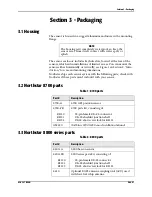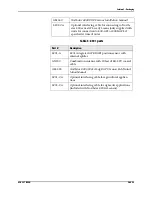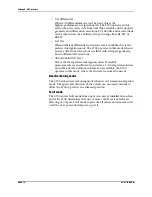
Section 4 - GPS receivers
05/01/97 REV H
PAGE 13
Self-test
Upon request from an external source via the GPS primary port, using
either RS-232 or RS-422, the 8700 enters self-test mode. This test requires
no more than 15 seconds. Upon completion, the 8700 reports the test
results on its primary port through an NMEA message that’s displayed on
the host PC, if available. Then, the 8700 proceeds either to initialization
mode if it passes the test, or to fault mode if it detects a problem.
Initialization
When either power is applied or the self-test mode is complete, the 8700
enters initialization mode. While in this mode, the 8700 retrieves satel-
lite-orbit data stored in its EEPROM memory. To ensure accuracy, the
8700 performs integrity checks on all data retrieved from the EEPROM.
After initialization, the sensor enters acquisition mode.
Acquisition mode
Whenever sufficient real-time satellite data is available to produce an ini-
tial navigation solution, the 8700 enters acquisition mode. Acquisition
mode can be entered from initialization, navigation, or dead-reckoning
modes (see below for separate descriptions of navigation and dead-reck-
oning modes).
The 8700 uses almanac data (stored in EEPROM memory) that describes
the satellite orbits, which helps quickly acquire signals from the GPS sat-
ellites. After each satellite in view is acquired, the 8700 collects its ephem-
eris data by decoding the satellite down-link data message. When enough
satellites are being tracked, the unit computes position, velocity, and
time, then enters navigation mode.
If valid almanac data is absent, and the 8700 can’t acquire signals nor-
mally, it initiates a “search the sky” acquisition, attempting to acquire all
satellites in the GPS constellation. In search the sky, the TTFF typically is
less than five minutes. After it acquires each satellite, ephemeris data is
decoded from the satellite down-link message. When enough satellites
are being tracked, the 8700 enters navigation mode—although it exits to
fault mode if it detects a problem.
Navigation mode
The 8700 enters navigation mode whenever sufficient satellite informa-
tion and measurement data is available to produce a GPS fix. The unit
enters navigation mode from acquisition or dead-reckoning modes, and
exits to dead-reckoning or fault mode.
Navigation mode consists of four sub-modes. The 8700 automatically
chooses the highest-performance sub-mode available for the satellite data
that it currently receives. On its primary port, it reports the current navi-
gation sub-mode:
•
3-D Differential
This navigation mode has the highest performance. The 8700
operates in this mode when it receives data from at least four
satellites with adequate geometry and differential corrections.
Differential SC-104 corrections can be taken in the auxiliary data
port using either RS-232 or RS-422.
Summary of Contents for 8700
Page 2: ......
Page 10: ......
Page 16: ...Section 2 Introduction PAGE 6 05 01 97 REV H ...
Page 20: ...Section 3 Packaging PAGE 10 05 01 97 REV H ...
Page 32: ...Section 6 GPS beacon combination receivers PAGE 22 05 01 97 REV H ...
Page 46: ...Section 8 Input output configurations PAGE 36 05 01 97 REV H ...
Page 52: ...Section 9 Connector pinouts PAGE 42 05 01 97 REV H ...
Page 76: ...Section 12 8X00 engine monitor program PAGE 66 05 01 97 REV H ...
Page 78: ...Section 13 Glossary PAGE 68 05 01 97 REV H ...
Page 80: ...Section 14 Abbreviations and initialisms PAGE 70 05 01 97 REV H ...
Page 85: ...Index 05 01 97 REV H PAGE 75 ...






























